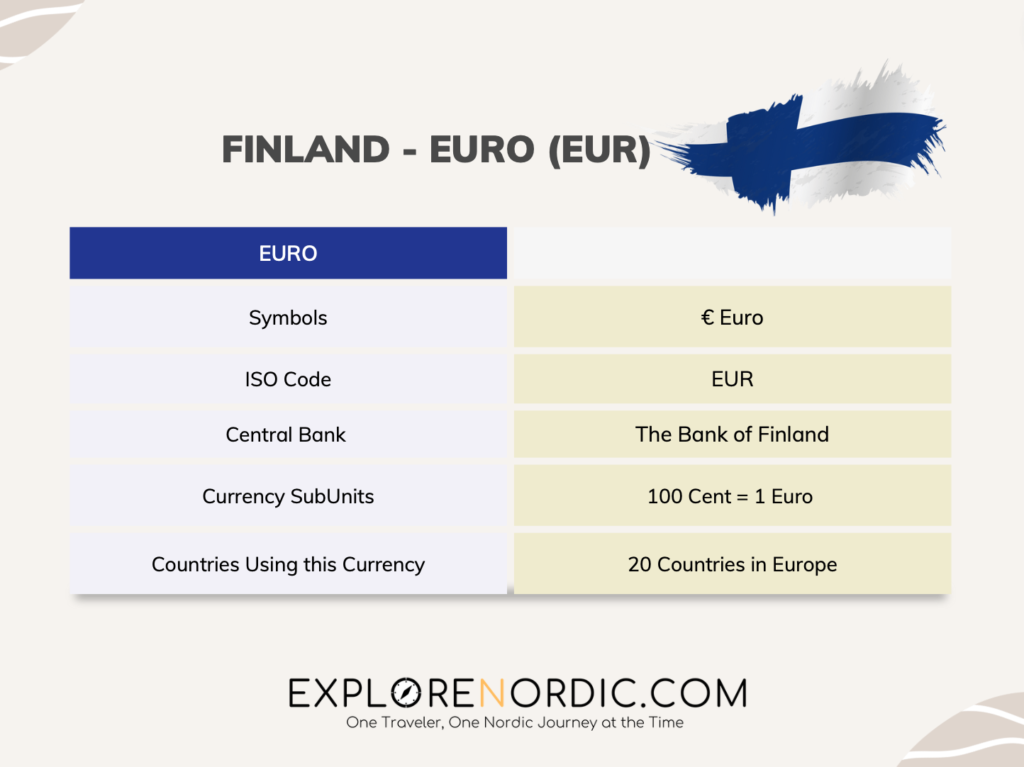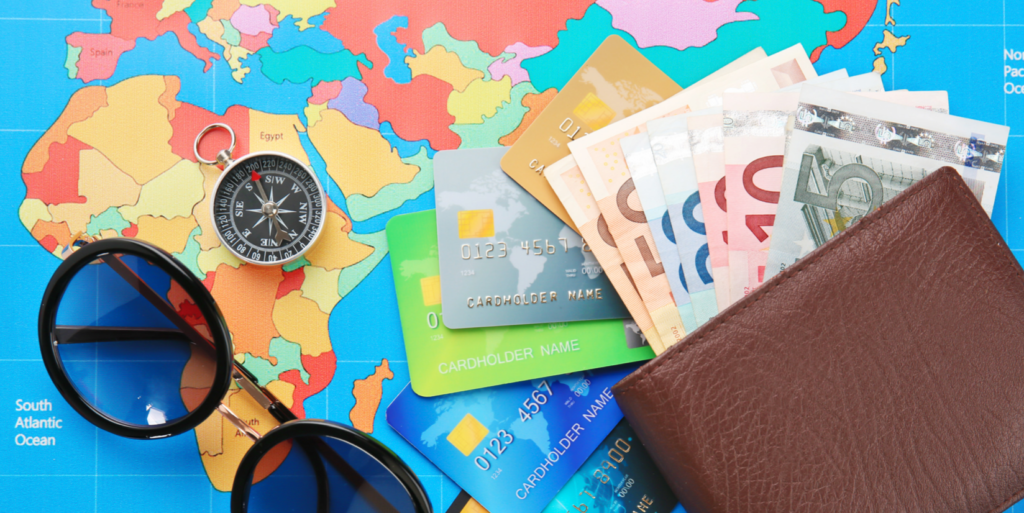Finland is a Northern European country with a population of approximately 5.5 million people. The country is known for its stunning natural beauty. Including numerous lakes and forests, as well as its vibrant and modern cities. But when you visit what currency do you use? What Is the Currency in Finland?
The euro is the official currency of 20 European Union member states, including Finland. The currency in Finland is the euro. It was introduced in 1999 as an electronic currency, and physical coins and banknotes were first introduced in 2002. The euro is used by more than 344 million Europeans. Making it one of the most widely used currencies in the world.
In Finland, the euro is represented by the symbol €, and its ISO code is EUR. The euro banknotes come in denominations of 5, 10, 20, 50, 100, 200, and 500 euros. While the coins come in denominations of 1, 2, 5, 10, 20, and 50 cents, as well as 1 and 2 euro coins. The European Central Bank (ECB) is responsible for maintaining the stability of the euro and regulating its circulation throughout the Eurozone.

Major Credit Cards in Finland
Credit cards are common in Finland and widely used for everyday transactions. According to a report by the Bank of Finland, the use of payment cards, including credit cards, has been growing steadily in Finland over the past decade. In 2020, the number of card payments increased by 10.4% compared to the previous year. Card payments accounted for 61% of all payments made by Finnish consumers.
Most merchants in Finland accept credit cards. It’s common to pay with when purchasing groceries, dining out, and online shopping, for example. Additionally, many Finns use credit cards for travel, as they offer a convenient way to pay for expenses such as accommodations, transportation, and activities.
It’s worth noting that while credit card use is widespread in Finland, the country also has a strong tradition of cashless payments through other means, such as debit cards and mobile payments. However, credit cards are still a popular and convenient payment option for many Finns.
Some of the major credit cards accepted in Finland include:
- Visa: Visa is one of the most widely accepted credit cards in Finland. It is accepted by most merchants that accept credit card payments. Visa credit cards are issued by a number of different banks in Finland.
- Mastercard: Mastercard is also a popular credit card in Finland and is widely accepted by merchants across the country. Like Visa, Mastercard is issued by a number of different banks in Finland.
- American Express: While not as widely accepted as Visa or Mastercard, American Express is also an option in Finland. It is accepted by many major merchants, particularly in larger cities and tourist destinations.
- Diners Club: Diners Club is another credit card option in Finland, although it is less commonly accepted than Visa, Mastercard, or American Express.
It’s important to note that credit card acceptance may vary depending on the merchant. Additionally, some merchants in Finland may require a PIN code to complete a credit card transaction. So be sure to know your PIN if you plan to use your credit card in the country.
Finnish Payment Apps
There are several common payment apps and mobile payment options in Finland, including:
- MobilePay: MobilePay is a mobile payment app developed by Danske Bank that allows users to send and receive money. It also allows users to pay for goods and services, and split bills with friends. It’s widely used in Finland and accepted by many merchants.
- Pivo: Pivo is a mobile payment app developed by OP Financial Group that allows users to make payments, track their spending, and manage their finances. It’s accepted by many merchants in Finland, including some online stores.
- Siirto: Siirto is a mobile payment app developed by a consortium of Finnish banks that allows users to send and receive money instantly. It’s widely used in Finland and accepted by many merchants.
- Masterpass: Masterpass is a mobile payment platform developed by Mastercard that allows users to make payments at participating merchants using their mobile devices. It’s accepted by many merchants in Finland.
- Apple Pay and Google Pay: Apple Pay and Google Pay are mobile payment services that allow users to make payments with their mobile devices at participating merchants. They are both accepted by many merchants in Finland.
Many Finnish banks also offer their own mobile banking apps that allow users to make payments, transfer money, and manage their finances from their mobile devices. These apps may also offer mobile payment options.
Currency Exchange Offices
Currency exchange offices can be found in many locations in Finland. Particularly in major cities and tourist destinations. They offer services for exchanging foreign currencies into euros and vice versa. They also offer other financial services such as money transfers and cash withdrawals.
Some of the most common currency exchange offices in Finland include:
- Forex Bank: Forex Bank is a foreign exchange company with branches in several locations throughout Finland. They offer currency exchange services, as well as international money transfers and currency trading.
- Change Group: Change Group is a currency exchange company with several locations in Finland, particularly in tourist areas such as airports and train stations. They offer currency exchange services, as well as prepaid travel cards and other financial services.
- Tavex: Tavex is a currency exchange company with branches in several locations throughout Finland. They offer currency exchange services, as well as gold and silver trading.
When exchanging currency at a currency exchange office, be aware of the exchange rate and any fees or commissions that may be charged. Some currency exchange offices may charge higher fees or offer less favorable exchange rates than others. It’s a good idea to shop around and compare rates before making a transaction. Additionally, some banks in Finland may also offer currency exchange services. It may be worth checking with your bank to see if they offer competitive rates.
Bringing Money into Finland
Are there any restrictions on the amount of currency you can bring into Finland?
If you are traveling to Finland from a non-EU country, you are required to declare any currency or monetary instruments that you are carrying with you, if the total value exceeds €10,000. This includes cash, traveler’s checks, money orders, and other negotiable instruments. The declaration can be made to the Finnish Customs authorities upon arrival in Finland.
If you are traveling within the EU, you do not need to declare currency or monetary instruments that you are carrying with you, but you are still subject to the €10,000 threshold. If you are carrying more than €10,000 or its equivalent in another currency, you may be asked to provide proof of the origin of the funds.
It’s important to note that failure to declare currency or monetary instruments that exceed the €10,000 threshold can result in penalties and seizure of the funds. Additionally, if you are carrying a large amount of currency, you may be subject to additional security checks by customs or other authorities.
Taxes and Other Fees to Be Aware of in Finland
There are some fees and charges that visitors to Finland should be aware of. Here are some of the most common fees you may encounter:
- Value-added tax (VAT): In Finland, most goods and services are subject to a value-added tax, which is included in the price. The standard VAT rate is 24%, although some items, such as food and books, are subject to a reduced rate of 14%.
- ATM fees: If you use an ATM to withdraw cash in Finland, you may be charged a fee by your bank or the ATM operator. Additionally, your bank may charge a foreign transaction fee for using your card in a foreign country.
- Credit card fees: If you use a credit card to make purchases in Finland, you may be charged a foreign transaction fee by your credit card issuer. Some merchants may charge a fee for using a credit card, although this is becoming less common.
- Accommodation tax: In some cities and municipalities in Finland, visitors may be required to pay an accommodation tax. The tax is typically a percentage of the cost of the accommodation and is collected by the hotel or other lodging establishments.
- Vehicle tax: If you plan to rent a car or other vehicle in Finland, you may be subject to a vehicle tax. The tax is typically included in the rental price and is used to fund road maintenance and other infrastructure projects.
- Alcohol and tobacco taxes: If you purchase alcohol or tobacco products in Finland, you will be subject to taxes on these items. The amount of tax varies depending on the type and quantity of the product.
It’s worth noting that some of these fees can be avoided or reduced by planning ahead and researching your options. For example, you may be able to find a bank or credit card issuer that offers lower foreign transaction fees.
Tipping in Finland

Tipping is not a common practice in Finland and is not expected in most situations. This is because service charges are generally included in the prices of goods and services. In restaurants, for example, a service charge is typically included in the menu prices. So there is no need to leave an additional tip. However, if you receive exceptional service, it is still possible to leave a small tip as a gesture of appreciation.
If you do choose to tip in Finland, it’s generally acceptable to round up the bill or leave a small amount of loose change. For example, if your bill is 24 euros, you might round up to 25 euros.
In some situations, such as when using a taxi, it’s common to simply round up the fare to the nearest euro. For example, if your taxi fare is 12.50 euros, you might give the driver 13 euros and consider the extra 50 cents as a small tip.
What Is the Currency in Finland? Finland and the Euro
Finland is a member of the European Union and has been a member of the Eurozone since its inception in 1999. In 2002 the Euro became Finland’s official currency.
The decision to adopt the Euro was based on a desire to further integrate with other European countries. It was also to promote economic stability and growth. Since then, Finland has been an active participant in the Eurozone and has played a key role in shaping its policies.
Benefits Adopting the Euro
One of the main benefits of adopting the Euro for Finland was the reduction of exchange rate risks and transaction costs associated with international trade. This has made it easier for Finnish companies to do business with other Eurozone countries. The Euro has also facilitated cross-border investment, which has helped to boost economic growth and job creation in Finland.
Another advantage of the Euro for Finland has been the increased credibility and stability it has provided to the Finnish economy. The Euro is a widely recognized and respected currency, and its adoption has helped to reduce the risk of financial instability and inflation. This has been particularly important for Finland. Since it has a small and open economy that is heavily dependent on exports.
The Finnish government has been actively involved in shaping Eurozone policies, particularly in the areas of fiscal discipline and financial regulation. Finland has been a strong proponent of balanced budgets and responsible fiscal management. It has advocated for greater regulatory oversight of the financial sector to prevent future crises.
Financial Challenges for Finland
Despite the benefits of adopting the Euro, Finland has also faced some challenges since joining the Eurozone. One of the main challenges has been the impact of the 2008 financial crisis, which led to a recession in Finland and other Eurozone countries. This has put pressure on the Finnish economy and forced the government to implement austerity measures to reduce its budget deficit.
Another challenge has been the rise of populist and nationalist movements in Finland and other European countries. These movements have called for the breakup of the Eurozone and a return to national currencies. However, such a move is seen as unlikely by most experts, as it would be difficult and costly to implement and could lead to further economic instability.
A Look at The Euro in General
The Euro is the official currency of the Eurozone, which is a monetary union of 20 European Union member states. It was introduced in 1999 and replaced the national currencies of participating countries. The Euro has become an integral part of the global financial system and is widely used for international trade and investment. The member countries are;
- Austria
- Belgium
- Croatia
- Cyprus
- Estonia
- Finland
- France
- Germany
- Greece
- Ireland
- Italy
- Latvia
- Lithuania
- Luxembourg
- Malta
- Netherlands
- Portugal
- Slovakia
- Slovenia
- Spain
The introduction of the Euro was a major step towards European integration. It was seen as a way to promote economic and political cooperation between member states. It also increase the region’s influence in the global economy. The Euro has also helped to reduce currency exchange costs and risks, making it easier for businesses to operate across borders.
Currently, Euro is the second most traded currency in the world. after the US dollar. The currency is used by around 342 million people on a daily basis. It is also the official currency of several non-EU countries, such as Montenegro and Kosovo. It’s a stable currency, and its value is influenced by a variety of factors such as inflation rates, economic growth, and political stability.
European Central Bank
The Euro is managed by the European Central Bank (ECB), which sets monetary policy for the Eurozone. The ECB’s main goal is to maintain price stability and support economic growth. To achieve this, the ECB can adjust interest rates, purchase or sell government bonds, and provide liquidity to banks.
Despite its many benefits, the Euro has also faced several challenges over the years. One of the biggest challenges was the 2008 financial crisis. This led to a recession in the Eurozone and raised concerns about the stability of the currency. The crisis highlighted the need for better economic coordination and fiscal discipline among member states.
Another challenge has been the rise of anti-EU sentiment and nationalist movements in some member states. These movements have called for the breakup of the Eurozone and a return to national currencies. However, such a move would be difficult and costly and is not currently seen as a viable option by most experts.
What Is the Currency in Finland – Conclusion
In conclusion, Finland is a country with a rich history and a unique culture that has earned it a place among the most prosperous and innovative nations in the world. The adoption of the Euro has facilitated trade and commerce within the EU and has provided stability to Finland’s economy. Finland remains an attractive destination for investors and tourists alike. Its currency, the Euro, is a symbol of its strong ties to the European Union and its commitment to economic stability and growth.
Relevant Reads:
17 Things To Do In Helsinki – Best Experiences In The Finnish Capital
29 Northern Lights Tours in Iceland, Norway, Finland, and Sweden
- The Swedish Currency
- The Norwegian Currency – coming soon
- The Danish Currency – coming soon
- The Icelandic Currency – coming soon





